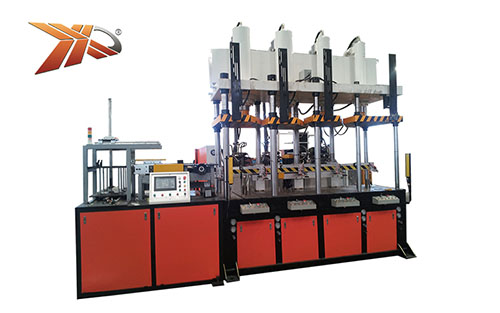All hydraulic systems have high-precision components and are highly susceptible to very small amounts of contamination. Even tiny metal particles moving between closely fitting reciprocating surfaces can quickly bring the most powerful hydraulic system to the knee. Therefore, hydraulic oil contamination is the biggest concern of maintenance managers, which is why you should look for situations that can minimize impurities and particles in hydraulic oil. With this in mind, you can take some simple measures to reduce the level of pollution in the hydraulic system.

1) Take samples regularly and keep records of hydraulic oil condition.
One way to reduce pollution is to always know the level of pollution within the system. Doing so will alert you to the problem when any unusual events occur. If the pollution level suddenly rises, it indicates that there may be a problem somewhere in the system. For example, components may wear out or seals may fail-leading to an increase in foreign matter in the fluid.
Therefore, it is best to sample your fluid and record a daily, weekly or monthly log to pay close attention to the degree of contamination and understand the contamination pattern of the fluid in the system.
2) Replace the hydraulic oil according to the specified schedule.
By far, routine maintenance is the best way to ensure that the hydraulic oil remains clean and pollution-free. Hydraulic oil is a vulnerable part and needs to be replaced regularly. This involves completely draining and flushing the hydraulic system and replacing the old oxidized oil with fresh clean oil. Before the pollutant level rises, performing this operation regularly will reduce the amount of debris accumulation in the system, ensure that the chemical composition of the oil is maintained for a long time, and keep the pollutant level low.
3) When draining the hydraulic oil, please follow the correct steps.
Make sure to drain 100% of the old liquid and remove all possible impurities. To do this, make sure to start the system and raise it to operating temperature before draining the fluid. Doing so will move the fluid and release the precipitated sediment and suspend it in the fluid-this ensures that all these impurities leave the system when the fluid is discharged. If you suspect that oil or debris may have accumulated in the system, you can use low-viscosity oil to flush the system.
4) Before replenishing the system, please filter the new hydraulic oil.
Even new hydraulic oils are sometimes not 100 percent free of contaminants. In order to doubly ensure the cleanliness of the fluid, you can consider filtering the alternative hydraulic oil through a very fine 10 micron filter.
5) Use the correct hydraulic oil in the application.
Different fluids provide different wear protection and chemical stability properties, making them more or less suitable for different applications. There are several factors that may affect the selection of the required hydraulic oil-these factors include operating temperature, stroke speed, duty cycle and the chemical composition of the hydraulic oil. For example, hydrostatic transmissions and control mechanisms may require a different viscosity fluid than fluid power systems. Using fluids of the wrong specifications can lead to premature fluid failure and accelerated wear. Check the hydraulic oil recommendations with the equipment manufacturer.
6) Replace the hydraulic oil according to the working conditions.
Changes in temperature conditions and environmental factors may require a different selection of hydraulic oil. For example, a cold climate can cause a sharp drop in winter temperatures, which makes it necessary to use lower viscosity oil in the cold season. However, if the conditions change and you continue to use the machine, it may cause the fluid to become overheated, lose viscosity and decompose, which may accelerate wear and increase pollution. Check the equipment manufacturer's maintenance manual for guidance on using the correct fluid for different operating conditions.
7) Replace the hydraulic filter regularly.
Hydraulic filters are the best way to resist pollution, but when clogged, they lose their ability to effectively remove impurities from the fluid. Therefore, it is important to pay attention to the health of the filter and replace it according to the prescribed maintenance schedule. You can keep an accurate log detailing which filters have changed and when they need to be replaced, or you can use specially designed clogged filter indicators that can provide a visual signal to let you know when they need to be replaced.
A clean hydraulic system is a healthy hydraulic system. Hydraulic oil is the lifeline of the machine, just like you work better without impurities passing through the veins, your hydraulic oil must be kept clean and free of contaminants. These tips will help you reduce pollution levels and keep your hydraulic fluids healthy.
【Zhongyou Heavy Industryhydraulic technology advantages]
Zhongyou Heavy Industry in strict accordance with the ISO international standard quality management system and 5S management standards for quality control and internal management. The "Henan Province Fluid Pressure Forming Intelligent Equipment Engineering Technology Research Center" has been established. The core team is composed of dozens of doctors, masters and metal forming experts and professors from various colleges and universities, focusing on the research and development of hydraulic forming core technology and product process.

Zhongyou Heavy Industry has carried out long-term production, learning, and research cooperation with the Institute of Metals of the Chinese Academy of Sciences, Nanjing University of Aeronautics and Astronautics, and jointly established a "Hydroforming Technology Industrialization Demonstration Base" to track domestic and foreign technologies and continuously improve "Zhongyou Heavy Industry" hydraulic equipment brand value.










